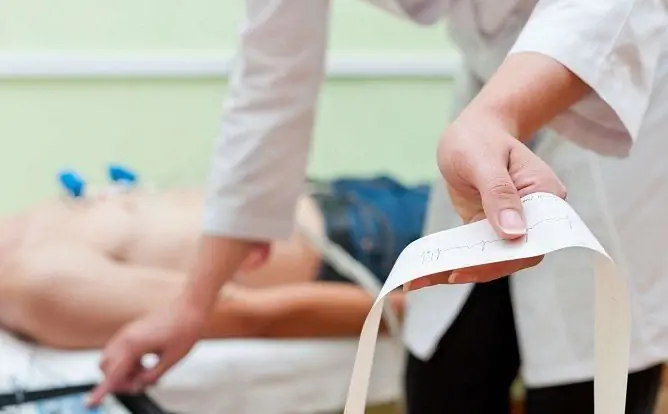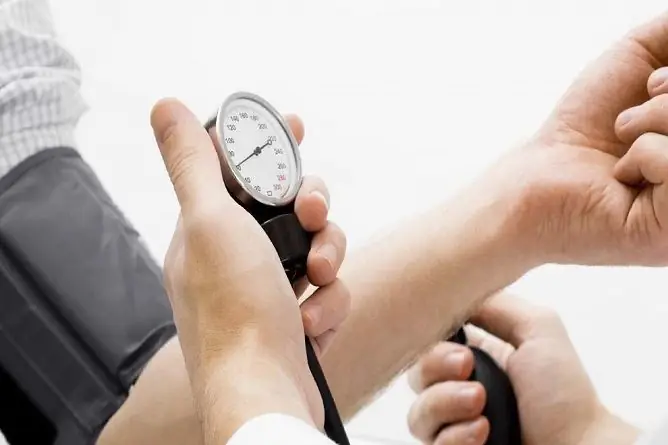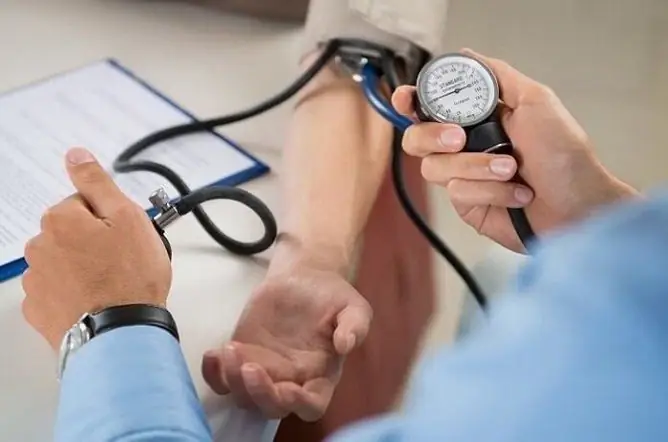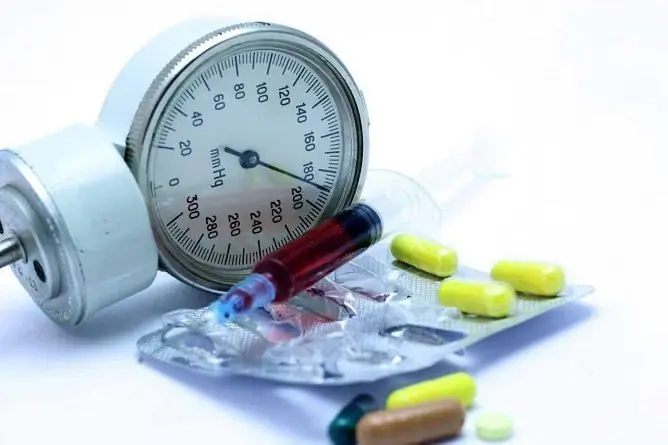- Author Rachel Wainwright [email protected].
- Public 2023-12-15 07:39.
- Last modified 2025-11-02 20:14.
Low blood pressure and low pulse: causes, symptoms, treatment
The content of the article:
- Blood pressure and pulse
- Low blood pressure and low pulse: causes
- Why a weak pulse and low blood pressure are dangerous
- Diagnostics
- First aid
- Surgical treatment of bradycardia
- Folk remedies
- Power features
- Prevention
- Video
Low blood pressure and low heart rate are not uncommon. The development of this condition may be due to reasons of both physiological and pathological nature. With a combination of severe hypotension (low blood pressure) and bradycardia (low heart rate), a person's blood supply to organs and tissues deteriorates, which leads to the development of hypoxia, hypoxemia, ischemia. In turn, these disorders can lead to the development of serious diseases and even death. Therefore, it is important to know what to do with low blood pressure and low heart rate.
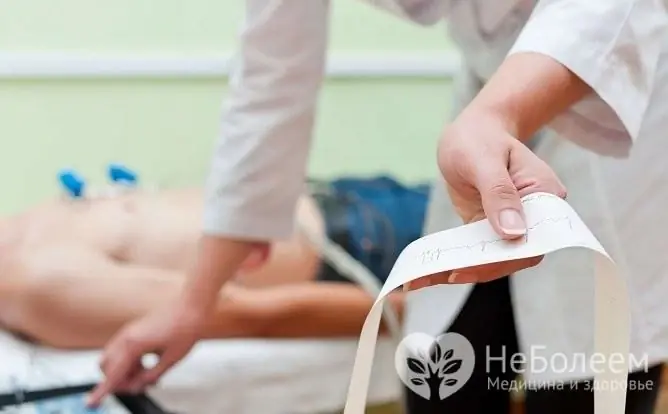
At low pressure with low pulse, the patient is assigned an ECG
Blood pressure and pulse
Blood pressure (BP) is the force with which blood acts on the walls of the arteries. This is one of the important indicators of hemodynamics.
Pulse is called jerky vibrations of the walls of the arteries caused by the movement of the blood pushed out by the heart. Usually, the pulse is studied on the radial artery, but other superficial arteries (temporal, carotid, femoral) are also excellent for this purpose.
Normally, in an adult, the pulse rate ranges from 60 to 90 beats per minute. A pulse of less than 60 beats per minute is called bradycardia, and its decrease to 50 beats per minute or less is already a threat to human life and health.
Normal blood pressure values per day are:
- systolic (upper, heart) pressure - 91-139 mm Hg. Art.;
- diastolic (lower, renal) - 61-89 mm Hg. Art.
Low blood pressure is called hypotension.
Low blood pressure and low pulse: causes
The combination of hypotension and bradycardia may not be associated with any disease, but caused by physiological factors.
- Hypothermia. Low temperatures reduce the tissue's need for oxygen and nutrients, so the heart starts to work less intensely, which leads to lower blood pressure and a decrease in heart rate.
- Pregnancy. In the third trimester of pregnancy, the fetus begins to squeeze the inferior vena cava. As a result, blood flow to the heart is reduced, which in turn causes a decrease in cardiac output. Clinically, this leads to a sharp drop in pressure, bradycardia.
- Professional sports. In well-trained people at rest, there is a decrease in the frequency of respiration and heart rate, blood pressure indicators, which is a variant of the physiological norm.
Why is low blood pressure with low heart rate abnormal? The reasons are as follows:
- ischemic heart disease (angina pectoris, myocardial infarction, postinfarction cardiosclerosis);
- atherosclerosis of the coronary arteries;
- weakness of the sinus node;
- congenital anomalies of the anatomical structure of the heart.
What does a sharp drop in blood pressure and a drop in heart rate mean? This is usually observed against the background of critical, life-threatening sick conditions:
- thromboembolism of the pulmonary artery or its large branches (PE);
- collapse or fainting;
- some acute poisoning;
- severe infectious diseases;
- generalized allergic reactions;
- heart rhythm disturbances;
- acute myocardial infarction.
Why a weak pulse and low blood pressure are dangerous
If a person has a pulse of less than 50 beats per minute, then this should be the reason for a medical examination. To confirm bradycardia, an ECG is required.
If the pulse rate drops to 40 beats per minute or less, then an ambulance team should be urgently called to the patient, since this condition can accompany extremely dangerous pathologies:
- atrial fibrillation;
- pulmonary embolism;
- myocardial infarction.
Consider what a small pulse and low blood pressure can lead to. A pronounced decrease in heart rate is accompanied by the development of hypoxia, which is manifested by the following symptoms:
- increased fatigue;
- general weakness;
- dizziness and headache;
- fainting;
- severe drowsiness during the daytime;
- chest pain;
- dyspnea;
- cold sweat;
- the appearance of swelling of soft tissues.
Diagnostics
Bradycardia and hypotension are quite serious symptoms that require a full medical examination, the program of which usually includes:
- consultation with a cardiologist and neurologist;
- electrocardiography;
- Echo-KG;
- chest x-ray;
- coronary angiography;
- blood tests (general, biochemical, coagulogram).
First aid
The algorithm of actions with a low pulse and pressure is largely determined by how severe these symptoms are.
With minor bradycardia, hypotension can be recommended to drink a cup of strong sweet tea or coffee. These drinks contain caffeine, which increases vascular tone and increases heart rate.
With mild bradycardia and hypotension, some folk remedies (tincture of eleutherococcus, ginseng or belladonna) also have a good effect.
According to the doctor's prescription at home, you can take medications containing caffeine (Citramon, Askofen).
With a sharp drop in pulse and pressure, the patient needs urgent hospitalization. In order to restore the heart rate, he is given injections of Atropine sulfate, Alupenta, Izadrin.
Surgical treatment of bradycardia
If conservative treatment in the elderly and young people does not lead to an improvement in hemodynamic parameters, then there are indications for the installation of a pacemaker.

Pulse is usually measured on the radial artery, although it is possible on any large, superficial
Folk remedies
By agreement with the attending physician, the therapy of hypotension and bradycardia can be supplemented with herbal medicine. Most often, experts recommend:
- A decoction of the herb St. John's wort, hawthorn and rose hips, radiola pink root. The listed plants are mixed in a ratio of 1: 1.5: 2: 2. Three tablespoons of the resulting collection are poured with two glasses of boiling water and insisted for 30-40 minutes. Filter and apply half a glass 3 times a day.
- Tincture of ginseng root. To prepare it, you need to grind 25 g of ginseng root and fill it with one liter of good vodka. Insist in a dark place for 21 days. They are filtering. Take three times a day, half an hour before meals, 15-20 drops. The course of treatment is 2 months.
- A mixture of walnut and lemon. Twist a pound of walnuts and 4 large lemons through a meat grinder. Add to the resulting mixture 20 g of granulated sugar, 250 ml of sesame oil and one liter of warm boiled water. Mix everything well and store in a well-sealed container in the refrigerator. Take three times a day for a tablespoon.
Power features
In case of hypotension and low heart rate, patients are recommended high-calorie, easily digestible food. Food should be taken 5-6 times a day in small portions. The diet should include seaweed, nuts, seafood, vegetables and fruits. It is also necessary to monitor compliance with the water regime. An adult should drink 1.5-2 liters of water per day.
Fatty and heavy dishes, animal fats, baked goods, pastries are excluded from the menu.
Prevention
To reduce the risk of cardiovascular disease, it is necessary to lead a healthy lifestyle from a young age, which means:
- rejection of bad habits;
- playing sports;
- proper balanced nutrition;
- compliance with the daily routine;
- avoidance of stressful situations.
In conclusion, I would like to emphasize once again that bradycardia and hypotension do not always mean a disease. But regardless of this, their appearance requires examination of the patient in order to establish the cause.
Video
We offer for viewing a video on the topic of the article.

Elena Minkina Doctor anesthesiologist-resuscitator About the author
Education: graduated from the Tashkent State Medical Institute, specializing in general medicine in 1991. Repeatedly passed refresher courses.
Work experience: anesthesiologist-resuscitator of the city maternity complex, resuscitator of the hemodialysis department.
Found a mistake in the text? Select it and press Ctrl + Enter.

